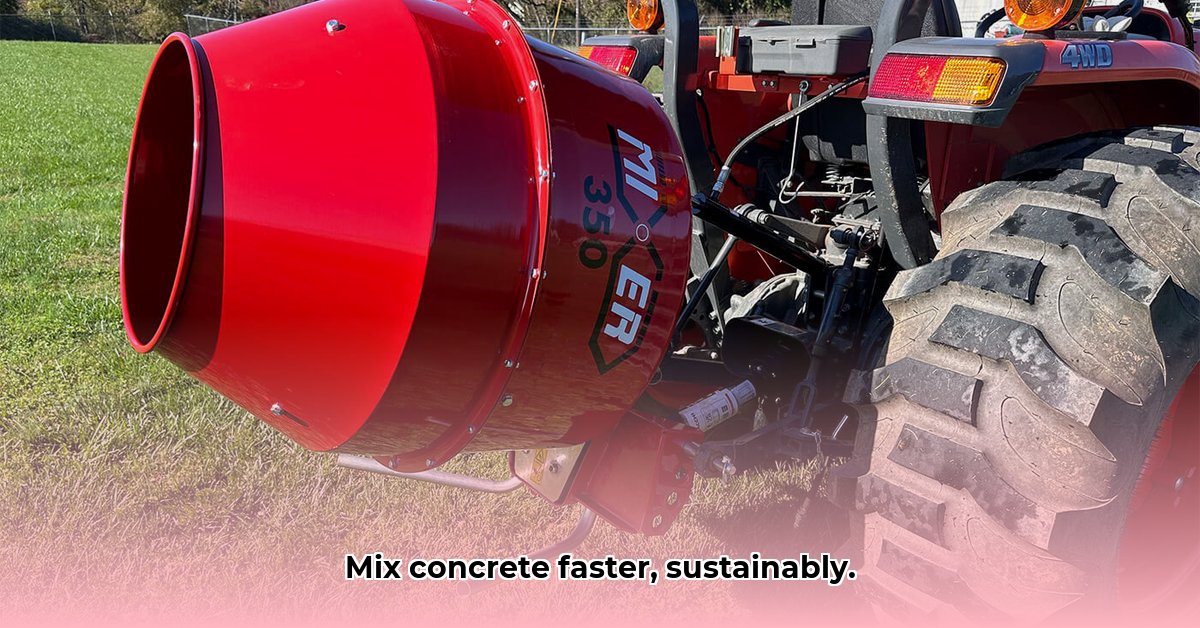
Tractor Cement Mixers: Revolutionizing Farm Construction
Farming is evolving beyond traditional planting and harvesting; resource management and environmental sustainability are paramount. A significant shift is occurring in concrete usage, a material crucial for farm repairs, new structures, and infrastructure improvements. Farmers are increasingly adopting on-farm concrete mixing, utilizing machines like the Cosmo Betomix MX80-350, to bypass the costs and inefficiencies of pre-mixed concrete delivery. For precision farming, consider using GPS technology. This article explores the advantages, disadvantages, and practical steps involved in implementing on-farm concrete mixing, providing a comprehensive analysis to help farmers and stakeholders determine if it's a viable solution for their operations.
Streamlining Concrete Production: The Perks of On-Farm Mixing
On-farm concrete mixing offers substantial time and cost savings. Eliminating the transportation of pre-mixed concrete significantly reduces expenses associated with fuel, vehicle wear and tear, and labor. This efficiency boost translates to significant financial advantages and allows farmers to concentrate on core agricultural tasks. Mixers such as the Cosmo Betomix MX80-350 are designed for ease of operation and maintenance, further enhancing efficiency. Isn't the ability to produce concrete on demand, precisely when and where needed, a game-changer for farm productivity? However, the scalability of these benefits needs careful consideration, relative to farm size and construction needs.
Environmental Impacts: A Balanced Perspective
While on-farm mixing drastically reduces transportation emissions—a significant environmental benefit—a holistic assessment is necessary. The manufacturing of the mixer itself, the sourcing of its components, and its eventual disposal all contribute to its overall environmental footprint. The energy consumption of the tractor used to power the mixer is another factor. However, these potential environmental drawbacks can be mitigated through sustainable practices. Prioritizing locally-sourced aggregates and environmentally friendly cement options, and incorporating recycled materials into the concrete mix, significantly reduces the overall environmental impact. Further research is needed to fully quantify the life-cycle environmental impact of on-farm concrete mixing.
Practical Considerations & Cost-Effectiveness
The suitability of on-farm concrete mixing depends heavily on the scale of the farm operation and its construction requirements. Smaller farms might find the initial investment substantial, while larger operations may require multiple mixers. A thorough cost-benefit analysis is crucial before investing. This analysis should incorporate various factors:
| Factor | Cost Calculation | Benefit |
|---|---|---|
| Initial Investment | Mixer purchase price + installation costs | Reduced transportation costs and faster project completion. |
| Operating Costs | Fuel, routine maintenance, labor, cement, and aggregates. | Increased efficiency, freeing up time for other farm operations. |
| Labor Savings | Reduced time for transportation and handling concrete. | More time devoted to core farming activities. |
| Maintenance Costs | Regular servicing and repairs; consider ease of maintenance before purchasing. | Minimized downtime and extended equipment lifespan. |
This table helps quantify the potential savings against initial investment costs. Remember to tailor the calculation specifically to your operation's needs.
Actionable Steps for Stakeholders
Successfully implementing on-farm concrete mixing requires a collaborative effort among farmers, manufacturers, and policymakers.
For Farmers:
- Conduct a comprehensive cost-benefit analysis: Carefully evaluate the financial implications considering your specific farm size and needs.
- Source sustainable materials: Prioritize locally-sourced aggregates and eco-friendly cement choices, including recycled materials wherever possible.
- Select the appropriately sized mixer: Choose a mixer commensurate with your construction needs; mismatching size will negatively impact efficiency and profitability.
For Equipment Manufacturers:
- Enhance data transparency: Provide detailed lifecycle assessments (LCAs) to demonstrate the environmental impact of your equipment throughout its lifespan.
- Publish precise performance data: Make readily available data concerning concrete output per hour and energy consumption.
- Collaborate for sustainability: Partner with sustainable material suppliers to offer comprehensive eco-friendly solutions.
For Policymakers and Researchers:
- Fund research on sustainable concrete mixes: Invest in research and development of environmentally friendly concrete mixtures specifically for agricultural applications.
- Develop sustainability standards: Establish clear standards for farm equipment incentivizing environmentally responsible manufacturing practices.
- Promote educational initiatives: Educate farmers on sustainable farming techniques, including best practices for concrete mixing.
Conclusion: A Sustainable and Profitable Solution?
The decision of whether to invest in on-farm concrete mixing involves a balanced assessment of economic and environmental implications. While the potential for increased efficiency and cost savings is substantial, a holistic evaluation of the entire life cycle of the machine and its materials is essential. This technology offers significant potential, and continued research, alongside collaboration between farmers, manufacturers, and policymakers, will further refine its role in creating a more sustainable and efficient agricultural future. Through careful planning and sustainable practices, on-farm concrete mixing offers a significant pathway to a more environmentally friendly and economically sound farming operation.